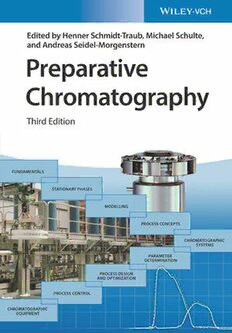
Preparative Chromatography PDF
Preview Preparative Chromatography
PreparativeChromatography Preparative Chromatography Editedby HennerSchmidt-Traub MichaelSchulte AndreasSeidel-Morgenstern ThirdEdition Editors AllbookspublishedbyWiley-VCH arecarefullyproduced.Nevertheless, Prof.(em.)Dr.-Ing.HennerSchmidt-Traub authors,editors,andpublisherdonot TUDortmund warranttheinformationcontainedin FakultütfürBio-und thesebooks,includingthisbook,to ChemieingenieurwesenLehrstuhlfür befreeoferrors.Readersareadvised Anlagen-und tokeepinmindthatstatements,data, ProzesstechnikEmil-Figge-Str.70 illustrations,proceduraldetailsorother 44227Dortmund itemsmayinadvertentlybeinaccurate. Germany LibraryofCongressCardNo.: Dr.MichaelSchulte appliedfor MerckKGaA LifeScience-Bioprocessing BritishLibraryCataloguing-in-Publication PurificationR&DFrankfurterStr.250 Data 64293Darmstadt Acataloguerecordforthisbookis Germany availablefromtheBritishLibrary. Prof.Dr.-Ing.AndreasSeidel-Morgenstern Bibliographicinformationpublishedby Otto-von-Guericke-Universität theDeutscheNationalbibliothek Institutfür TheDeutscheNationalbibliotheklists Verfahrenstechnik thispublicationintheDeutsche LehrstuhlfürChemische Nationalbibliografie;detailed Verfahrenstechnikand bibliographicdataareavailableonthe Max-Planck-InstitutfürDynamik Internetat<http://dnb.d-nb.de>. komplexertechnischer SystemeSandtorstraße1 ©2020Wiley-VCHVerlagGmbH& Universitätsplatz239106 Co.KGaA,Boschstr.12,69469 MagdeburgGermany Weinheim,Germany Cover Allrightsreserved(includingthoseof Thecoverimageofamulticolumn translationintootherlanguages).No continuousplantisreproducedby partofthisbookmaybereproducedin courtesyofNovasep,France. anyform–byphotoprinting, Thecoverimageofacolumnheadis microfilm,oranyothermeans–nor reproducedbycourtesyofMerck, transmittedortranslatedintoa Germany. machinelanguagewithoutwritten permissionfromthepublishers. Registerednames,trademarks,etc.used inthisbook,evenwhennotspecifically markedassuch,arenottobe consideredunprotectedbylaw. PrintISBN:978-3-527-34486-4 ePDFISBN:978-3-527-81631-6 ePubISBN:978-3-527-81633-0 oBookISBN:978-3-527-81634-7 CoverDesignFormgeber,Mannheim, Germany TypesettingSPiGlobal,Chennai,India PrintingandBinding Printedonacid-freepaper 10 9 8 7 6 5 4 3 2 1 v Contents Preface xv AbouttheEditors xvii ListofAbbreviations xix Notation xxiii 1 Introduction 1 HennerSchmidt-TraubandReinhardDitz 1.1 Chromatography,Development,andFutureTrends 1 1.2 FocusoftheBook 4 1.3 SuggestionsonHowtoReadthisBook 4 References 6 2 FundamentalsandGeneralTerminology 9 AndreasSeidel-Morgenstern 2.1 PrinciplesandFeaturesofChromatography 9 2.2 AnalysisandDescriptionofChromatograms 13 2.2.1 VoidageandPorosity 13 2.2.2 RetentionTimesandCapacityFactors 16 2.2.3 EfficiencyofChromatographicSeparations 17 2.2.4 Resolution 20 2.2.5 PressureDrop 23 2.3 MassTransferandFluidDynamics 25 2.3.1 PrinciplesofMassTransfer 25 2.3.2 FluidDistributionintheColumn 27 2.3.3 PackingNonidealities 28 2.3.4 Extra-ColumnEffects 29 2.4 EquilibriumThermodynamics 29 2.4.1 DefinitionofIsotherms 29 2.4.2 ModelsofIsotherms 31 2.4.2.1 Single-ComponentIsotherms 31 2.4.2.2 MulticomponentIsothermsBasedontheLangmuirModel 33 2.4.2.3 CompetitiveIsothermsBasedontheIdealAdsorbedSolution Theory 34 2.4.2.4 StericMassActionIsotherms 37 vi Contents 2.4.3 RelationBetweenIsothermsandBandShapes 38 2.5 ColumnOverloadingandOperatingModes 44 2.5.1 OverloadingStrategies 44 2.5.2 BeyondIsocraticBatchElution 45 References 46 3 StationaryPhases 49 MichaelSchulte 3.1 SurveyofPackingsandStationaryPhases 49 3.2 InorganicSorbents 50 3.2.1 ActivatedCarbons 50 3.2.2 SyntheticZeolites 54 3.2.3 PorousOxides:Silica,ActivatedAlumina,Titania,Zirconia,and Magnesia 54 3.2.4 Silica 55 3.2.4.1 SurfaceChemistry 57 3.2.4.2 MassLoadability 59 3.2.5 DiatomaceousEarth 59 3.2.6 ReversedPhaseSilicas 60 3.2.6.1 SilanizationoftheSilicaSurface 60 3.2.6.2 Silanization 60 3.2.6.3 StartingSilanes 61 3.2.6.4 ParentPorousSilica 61 3.2.6.5 ReactionandReactionConditions 62 3.2.6.6 Endcapping 62 3.2.6.7 ChromatographicCharacterizationofReversedPhaseSilicas 63 3.2.6.8 ChromatographicPerformance 63 3.2.6.9 HydrophobicPropertiesRetentionFactor(AmountofOrganic SolventforElution),Selectivity 65 3.2.6.10 ShapeSelectivity 65 3.2.6.11 SilanolActivity 67 3.2.6.12 Purity 68 3.2.6.13 ImprovedpHStabilitySilica 68 3.2.7 AluminumOxide 69 3.2.8 TitaniumDioxide 70 3.2.9 OtherOxides 71 3.2.9.1 MagnesiumOxide 71 3.2.9.2 ZirconiumDioxide 71 3.2.10 PorousGlasses 72 3.3 Cross-LinkedOrganicPolymers 73 3.3.1 GeneralAspects 74 3.3.2 HydrophobicPolymerStationaryPhases 77 3.3.3 HydrophilicPolymerStationaryPhases 78 3.3.4 IonExchange(IEX) 79 3.3.4.1 OptimizationofIon-ExchangeResins 81 3.3.5 MixedMode 88 3.3.6 Hydroxyapatite 88 Contents vii 3.3.7 DesignedAdsorbents 91 3.3.7.1 ProteinAAffinitySorbents 91 3.3.7.2 OtherIgGReceptorProteins:ProteinGandProteinL 96 3.3.7.3 SorbentsforDerivatized/TaggedCompounds:ImmobilizedMetal AffinityChromatography(IMAC) 96 3.3.7.4 OtherTag-BasedAffinitySorbents 101 3.3.8 CustomizedAdsorbents 102 3.3.8.1 LowMolecularWeightLigands 105 3.3.8.2 NaturalPolymers(Proteins,Polynucleotides) 108 3.3.8.3 ArtificialPolymers 111 3.4 AdvectiveChromatographicMaterials 111 3.4.1 AdsorptiveMembranesandGrafted-PolymerMembranes 114 3.4.2 AdsorptiveNonwovens 115 3.4.3 Fiber/ParticleComposites 117 3.4.4 Area-EnhancedFibers 117 3.4.5 Monolith 118 3.4.6 ChromatographicMaterialsforLargerMolecules 121 3.5 ChiralStationaryPhases 121 3.5.1 Cellulose-andAmylose-BasedCSP 122 3.5.2 AntibioticCSP 128 3.5.3 Cyclofructan-BasedCSP 128 3.5.4 SyntheticPolymers 128 3.5.5 TargetedSelectorDesign 130 3.5.6 FurtherDevelopments 132 3.6 PropertiesofPackingsandTheirRelevancetoChromatographic Performance 132 3.6.1 ChemicalandPhysicalBulkProperties 132 3.6.2 Morphology 133 3.6.3 ParticulateAdsorbents:ParticleSizeandSizeDistribution 133 3.6.4 PoreTexture 134 3.6.5 PoreStructuralParameters 137 3.6.6 ComparativeRatingofColumns 137 3.7 SorbentMaintenanceandRegeneration 138 3.7.1 CleaninginPlace(CIP) 138 3.7.2 CIPforIEX 140 3.7.3 CIPofProteinASorbents 140 3.7.4 ConditioningofSilicaSurfaces 143 3.7.5 SanitizationinPlace(SIP) 145 3.7.6 ColumnandAdsorbentStorage 145 References 146 4 SelectionofChromatographicSystems 159 MichaelSchulte 4.1 DefinitionoftheTask 164 4.2 MobilePhasesforLiquidChromatography 167 4.2.1 Stability 168 4.2.2 SafetyConcerns 172 viii Contents 4.2.3 OperatingConditions 172 4.2.4 AqueousBufferSystems 176 4.3 AdsorbentandPhaseSystems 178 4.3.1 ChoiceofPhaseSystemDependentonSolubility 178 4.3.2 ImprovingLoadabilityforPoorSolubilities 180 4.3.3 DependencyofSolubilityonSamplePurity 183 4.3.4 GenericGradientsforFastSeparations 184 4.4 CriteriaforChoosingNormalPhaseSystems 184 4.4.1 RetentioninNPSystems 186 4.4.2 SolventStrengthinLiquid–SolidChromatography 188 4.4.3 PilotTechniqueThin-LayerChromatographyUsingthePRISMA Model 190 4.4.3.1 Step(1):SolventStrengthAdjustment 199 4.4.3.2 Step(2):OptimizationofSelectivity 199 4.4.3.3 Step(3):FinalOptimizationoftheSolventStrength 200 4.4.3.4 Step(4):DeterminationoftheOptimumMobilePhase Composition 200 4.4.4 StrategyforanIndustrialPreparativeChromatography Laboratory 202 4.4.4.1 StandardGradientElutionMethodonSilica 203 4.4.4.2 SimplifiedProcedure 204 4.5 CriteriaforChoosingReversedPhaseSystems 206 4.5.1 RetentionandSelectivityinRPSystems 208 4.5.2 GradientElutionforSmallAmountsofProductonRPColumns 212 4.5.3 RigorousOptimizationforIsocraticRuns 213 4.5.4 RigorousOptimizationforGradientRuns 217 4.5.5 PracticalRecommendations 222 4.6 CriteriaforChoosingCSPSystems 223 4.6.1 SuitabilityofPreparativeCSP 223 4.6.2 DevelopmentofEnantioselectivity 224 4.6.3 OptimizationofSeparationConditions 226 4.6.3.1 DeterminationofRacemateSolubility 226 4.6.3.2 SelectionofElutionOrder 226 4.6.3.3 OptimizationofMobile/StationaryPhaseComposition,Including Temperature 226 4.6.3.4 DeterminationofOptimumSeparationStep 227 4.6.4 PracticalRecommendations 227 4.7 DownstreamProcessingofmAbsUsingProteinAandIEX 231 4.8 Size-ExclusionChromatography(SEC) 236 4.9 OverallChromatographicSystemOptimization 237 4.9.1 ConflictsDuringOptimizationofChromatographicSystems 237 4.9.2 StationaryPhaseGradients 241 References 246 5 ProcessConcepts 251 MalteKaspereitandHennerSchmidt-Traub 5.1 DiscontinuousProcesses 252 Contents ix 5.1.1 IsocraticOperation 252 5.1.2 GradientChromatography 253 5.1.3 Closed-LoopRecyclingChromatography 256 5.1.4 Steady-StateRecyclingChromatography(SSRC) 258 5.1.5 Flip-FlopChromatography 259 5.1.6 ChromatographicBatchReactors 260 5.2 ContinuousProcesses 261 5.2.1 ColumnSwitchingChromatography 262 5.2.2 AnnularChromatography 262 5.2.3 MultiportSwitchingValveChromatography(ISEP/CSEP) 263 5.2.4 IsocraticSimulatedMovingBed(SMB)Chromatography 264 5.2.5 SMBChromatographywithVariableProcessConditions 268 5.2.5.1 Varicol 269 5.2.5.2 PowerFeed 270 5.2.5.3 Partial-Feed,Partial-Discard,andFractionation-Feedback Concepts 271 5.2.5.4 Improved/IntermittentSMB(iSMB) 271 5.2.5.5 Modicon 273 5.2.5.6 FF-SMB 273 5.2.6 GradientSMBChromatography 274 5.2.7 SupercriticalFluidChromatography(SFC) 275 5.2.7.1 SupercriticalBatchChromatography 276 5.2.7.2 SupercriticalSMBprocesses 277 5.2.8 MulticomponentSeparations 277 5.2.9 MulticolumnSystemsforBioseparations 278 5.2.9.1 MulticolumnCaptureChromatography(MCC) 279 5.2.9.2 MulticolumnCountercurrentSolventGradientPurification (MCSGP) 286 5.2.10 CountercurrentChromatographicReactors 288 5.2.10.1 SMBReactor 288 5.2.10.2 SMBReactorswithDistributedFunctionalities 290 5.3 ChoiceofProcessConcepts 292 5.3.1 Scale 292 5.3.2 Rangeofk′ 292 5.3.3 NumberofFractions 293 5.3.4 Example1:LabScale;TwoFractions 293 5.3.5 Example2:LabScale;ThreeorMoreFractions 294 5.3.6 Example3:ProductionScale;WideRangeofk′ 296 5.3.7 Example4:ProductionScale;TwoMainFractions 297 5.3.8 Example5:ProductionScale;ThreeFractions 298 5.3.9 Example6:ProductionScale;MultistageProcess 300 References 302 6 ModelingofChromatographicProcesses 311 AndreasSeidel-Morgenstern 6.1 Introduction 311 6.2 ModelsforSingleChromatographicColumns 311 x Contents 6.2.1 EquilibriumStageModels 312 6.2.1.1 DiscontinuousModelAccordingtoCraig 313 6.2.1.2 ContinuousModelAccordingtoMartinandSynge 315 6.2.2 DerivationofContinuousMassBalanceEquations 316 6.2.2.1 MassBalanceEquations 318 6.2.2.2 ConvectiveTransport 320 6.2.2.3 AxialDispersion 320 6.2.2.4 IntraparticleDiffusion 321 6.2.2.5 MassTransferBetweenPhases 321 6.2.2.6 FiniteRatesofAdsorptionandDesorption 322 6.2.2.7 AdsorptionEquilibria 323 6.2.3 EquilibriumModelofChromatography 323 6.2.4 ModelswithOneBandBroadeningEffect 329 6.2.4.1 EquilibriumDispersionModel 329 6.2.4.2 FiniteAdsorptionRateModel 331 6.2.5 ContinuousLumpedRateModels 331 6.2.5.1 TransportDispersionModels 332 6.2.5.2 LumpedFiniteAdsorptionRateModel 333 6.2.6 GeneralRateModels 333 6.2.7 InitialandBoundaryConditionsoftheColumn 335 6.2.8 DimensionlessModelEquations 336 6.2.9 ComparisonofDifferentModelApproaches 338 6.3 IncludingEffectsOutsidetheColumns 343 6.3.1 ExperimentalSetupandSimulationFlowSheet 343 6.3.2 ModelingExtra-ColumnEquipment 345 6.3.2.1 InjectionSystem 345 6.3.2.2 Piping 345 6.3.2.3 Detector 345 6.4 CalculationMethodsandSoftware 346 6.4.1 AnalyticalSolutions 346 6.4.2 NumericalSolutionMethods 346 6.4.2.1 Discretization 346 6.4.2.2 GeneralSolutionProcedureandSoftware 349 References 350 7 DeterminationofModelParameters 355 AndreasSeidel-Morgenstern,AndreasJupke,andHennerSchmidt-Traub 7.1 ParameterClassesforChromatographicSeparations 355 7.1.1 DesignParameters 355 7.1.2 OperatingParameters 356 7.1.3 ModelParameters 356 7.2 ConcepttoDetermineModelParameters 357 7.3 DetectorsandParameterEstimation 359 7.3.1 CalibrationofDetectors 359 7.3.2 ParameterEstimation 360 7.3.3 EvaluationofChromatograms 362 7.4 DeterminationofPackingParameters 363
